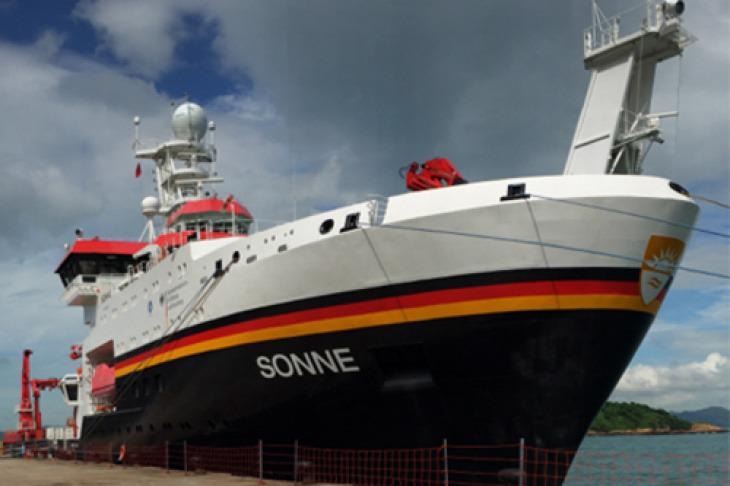 By Rolf EastoReviewed by Rolf EastoJun 9 2022
By Rolf EastoReviewed by Rolf EastoJun 9 2022At the Helmholtz-Zentrum Hereon, samples collected from the tropical Indian Ocean were examined by scientists by making use of a new technique for the extraction and identification of microplastic particles gathered from water samples.
 The Hereon was on the expedition research vessel SONNE in the Indian Ocean. Image Credit: Hereon/ Fadi El Gareb.
The Hereon was on the expedition research vessel SONNE in the Indian Ocean. Image Credit: Hereon/ Fadi El Gareb.
The outcome: The burden seems to be evidently measurable. The Hereon Institute for Coastal Environmental Chemistry performs research regarding the exact size, occurrence, and chemical composition of microplastics present in the surrounding. Also, the interactions between microplastics and other pollutants are already present in the surrounding.
The study has been reported in the Environmental Pollution journal.
The appearance of microplastic particles may be small, but they result in global issues for humans and the surrounding. These are plastic particles with a diameter ranging between 1 μm and 5 mm. Their precise analysis is a huge task as a result of the high error rates and the high time demand of earlier techniques.
The significantly enhanced analysis of microplastics was performed with the help of a new method known as Laser Direct Infrared (LDIR) Chemical Imaging. It was integrated with a new sample preparation protocol that has the potential to decompose interfering components of the sample with fewer work steps by enzymatic and chemical reactions.
The development of the protocol was done in the Department of Inorganic Environmental Chemistry headed by Dr. Daniel Pröfrock. The chemical characterization of the microplastic particles depends on their absorption of infrared light.
In this study, the device, which uses a so-called quantum cascade laser, demonstrated its advantages in the analysis of microplastic particles in environmental samples. It is fast and automatable, which is important for a future standard procedure.
Dr. Lars Hildebrandt, Study Co-First Author, Helmholtz-Zentrum Hereon
In the Upper Water Layers
An average concentration of around 50 microplastic particles and fibers per cubic meter of water was discovered in near-surface water of the tropical Indian Ocean. This is abruptly high for the open ocean.
The most common types of plastic were paint particles (49%), probably sourced from abrasion of ship painting, followed by polyethylene terephthalate (PET) along with a share of 25%.
Amongst other things, PET has been utilized in synthetic clothing as polyester microfibers and also for the production of beverage bottles. It possibly penetrates the surrounding via washing clothes. Also, microplastic particles are developed through the fragmentation of PET bottles, for instance, as a result of solar radiation or mechanical stress.
Recently, the microplastic pollution in the surrounding has increased. At present, plastic particles have been detected in nearly all living organisms that are analyzed.
Our results show that many microplastic particles, such as polypropylene, polystyrene, and polyethylene, have been fragmented on their way from land-based sources to the open ocean. Thus, they are even more easily ingested by organisms.
Fadi El Gareb, Study Co-First Author, Helmholtz-Zentrum Hereon
El Gareb added, “Through the Sunda Strait, a strait between Sumatra and Java, a large share of the found plastic waste may have entered the Indian Ocean, making it a hotspot in terms of microplastic pollution.”
A considerable portion of the world’s plastic waste is exported to countries that are bordering the Indian Ocean. As a result of ineffective waste management, nearly five million tons of plastic waste have been released annually into the marine environment from China and the Indonesian archipelago (model-based estimate from 2017).
A Look into the Future
For future investigations, the authors of the study also wish to analyze the presence of microplastic in other oceans by making use of the new analysis technique. Hereon-scientist Dr. Tristan Zimmermann has already sampled parts of the North Atlantic as part of another study.
We will sample arctic waters at the east coast of Greenland this August during a cruise with the research vessel MARIA S. MERIAN. Here, the data basis regarding microplastic particles is still very insufficient.
Dr Tristan Zimmermann, Scientist, Helmholtz-Zentrum Hereon
The researchers want to answer the question: How significant is microplastic pollution in remote regions and is it more severe than expected?
Journal Reference:
Hildebrandt, L., et al. (2022) Spatial distribution of microplastics in the tropical Indian Ocean based on laser direct infrared imaging and microwave-assisted matrix digestion. Environmental Pollution. doi.org/10.1016/j.envpol.2022.119547